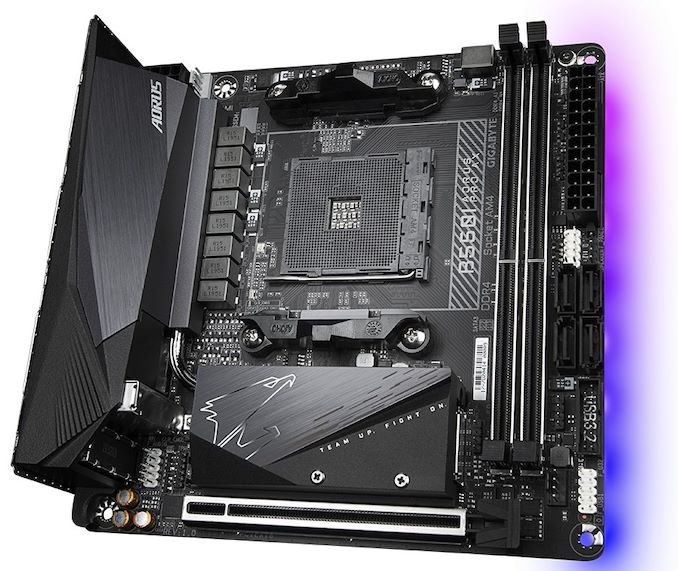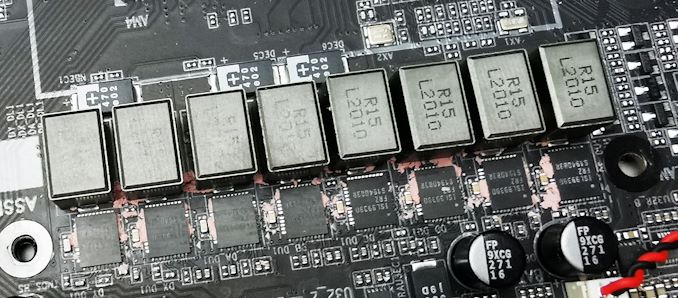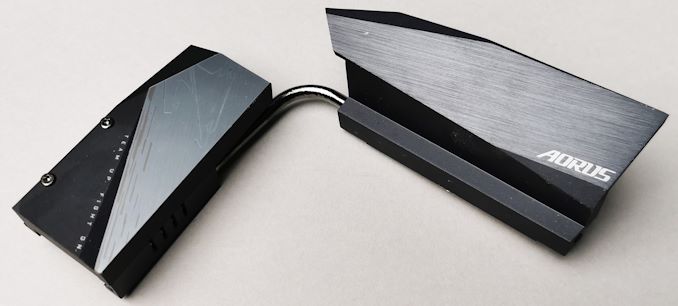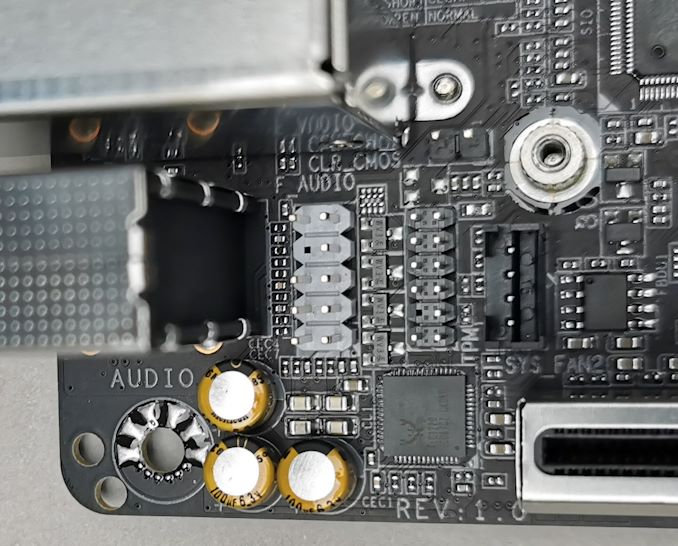The GIGABYTE B550I Aorus Pro AX Motherboard Review: All The Small Things
by Gavin Bonshor on December 7, 2020 10:00 AM ESTVisual Inspection
Looking very closely at the GIGABYTE B550I Aorus Pro AX motherboard, it has a small but capable frame with a very neutral aesthetic. It employs a primarily black and grey design, with a silver combined chipset and front-mounted M.2 heatsink, with one section of RGB LED lighting, which lights up the board's underside along the right. For users looking to add a little more pizazz, GIGABYTE includes an addressable and regular RGB LED strip pairing compatible with a lot of different RGB ecosystems, including Corsair's iCUE and NZXT CAM. However, GIGABYTE has its own called RGB Fusion 2.0.
Despite being mini-ITX, the GIGABYTE B550I Aorus Pro AX has plenty to focus on. Looking at expansion support, there is a single full-length PCIe 4.0 x16 slot, with the capability to install up to one PCIe 4.0 x4 M.2 slot on the front of the board, with a second slot on the rear of the PCB with support for both PCIe 3.0 x4 and SATA drives. There are four SATA ports for SATA devices, which are all straight angled and sit directly below the 24-pin ATX 12 V power input. These SATA ports do include support for RAID 0, 1, and 10 arrays, and they don't share bandwidth with any of the M.2 slots, even when SATA based M.2 drives are installed.
Users familiar with the mini-ITX form factor can appreciate that there will be limitations in connectivity, both internal and external. One of these is prevalent in its support for cooling, with just three 4-pin fan headers available on the B550I Aorus Pro AX model. One of these is dedicated to a CPU fan, while the other two are for chassis fans, although AIO pumps are supported through all three headers.
Memory compatibility looks strong with GIGABYTE's official support for up to DDR4-5100 memory, with a total capacity of up to 64 GB. Both of the memory slots and the full-length PCIe 4.0 x16 slot come with PCIe armor, designed to reinforce the slot to avoid physical damage to the slots when installing hardware. This also gives the slots better structure for heavier components such as NVIDIA's latest RTX 3090 graphics card, which is notoriously large and bulky.
For the power delivery, GIGABYTE is using an 8-phase design, which is being controlled by a Renesas RAA229004 PWM controller. The configuration is split into a 6+2 configuration, with six premium Intersil ISL99390 90 A power stages for the CPU and two ISL99390 90 A power stages for the SoC. On paper, this is one of the most capable mini-ITX models from the B550 models in regards to maximum power output to the CPU, with a maximum output of up to 540 A for the CPU. Delivering power to the CPU is a single 8-pin 12V ATX power connector.
The power delivery heatsink is interconnected to the M.2 and chipset heatsink, a common theme on mini-ITX models. It doesn't include finned heatsinks, so it relies primarily on mass, although the heatsink's top will catch airflow within a chassis. Unlike the X570 variant, there is no cooling fan above the chipset heatsink, which is a plus as it should be more than adequate without one.
The GIGABYTE B550I Aorus Pro AX is using a simplistic yet premium audio setup. It includes three Japanese Nichicon gold audio capacitors, with the driving being done by a Realtek ALC1220-VB HD audio codec. This is cramped in directly next to the end of the full-length PCIe slot, with no EMI shielding and no visible audio PCB segregation. There is also a front panel audio header, which is also powered by the ALC1220HD codec, although it is in this funny little position. This might interfere with the backplates on some of the larger graphics cards.
For a small board such as this one, it has an acceptable amount of connectivity on the rear panel, which is largely down to space restrictions. Starting with USB, the B550I Aorus Pro AX makes use of two USB 3.2 G2 ports, one Type-A, and one Type-C, with four additional USB 3.2 G1 Type-A ports. While this in itself isn't a lot, GIGABYTE does include a USB 3.2 G1 and USB 2.0 front panel heading pairing, which each allows a further four ports (two each) to be added to the system. The networking configuration is premium, with a Realtek RTL8125 2.5 GbE port, with two antenna ports for the Intel AX200 interface with Wi-Fi 6 and BT 5.0 support. Three 3.5 mm audio jacks are driven by a Realtek ALC1220-VB HD audio codec, while a trifecta of video outputs consisting of two HDMI 2.1 and a DisplayPort allows users to utilize the Ryzen 4000 APU's. Finishing off the rear panel is a Q-Flash Plus button.
















76 Comments
View All Comments
mkarwin - Tuesday, December 15, 2020 - link
It might have inferior codec setup, but allows better flexibility and connectability using the rear panel I/O audio ports...Questor - Wednesday, December 9, 2020 - link
Unfortunately for Gigabyte, the lack of a front USB-C header is a deal breaker. I had the same thought you did, hoping and holding out for a V2.Gigaplex - Wednesday, December 9, 2020 - link
How much of a dealbreaker? You can get USB3 to USB-C header adapters.Questor - Thursday, December 10, 2020 - link
Hm. I didn't think about that. Amazing how we miss things right in front of us. Not so much of a deal breaker me thinks. As long as the USB connection is reachable, since it wasn't placed as a front panel header.OliveGray - Sunday, December 13, 2020 - link
These are 2 pay checks $78367 and $87367. that i received in last 2 months. I am very happy that i can make thousands in my part time and now i am enjoying my life. Everybody can do this and earn lots of dollars from home in very short time period. Just visit this website now. Your Success is one step away Copy and Paste___bit.ly/googlework43kkilobyte - Monday, December 7, 2020 - link
Hopefully, it isn't as buggy as their X570 motherboards, that drop dead randomly and require removing the CMOS battery to be able to start it again - an issue that Gigabyte, in more than a year, never solved or even tried to solve.meacupla - Monday, December 7, 2020 - link
That seems to be a common issue on any Gigabyte motherboard.It's like their EEPROM chips have a 50% failure rate within 3yrs and 90% in 5yrs
Deicidium369 - Monday, December 7, 2020 - link
I have dozens in service - some going back to Conroe and never once have had a EEPROM die - maybe you should look at your power delivery system.Samus - Monday, December 7, 2020 - link
I’ve seen EEPROM failure on a few gigabyte boards going back to socket 939 it’s widely known to be an issue and Gigabyte seemingly knows it because they were making the first (only behind ABIT and DFI) to advocate ‘DualBIOS’ which they naturally did away with awhile back because it is expensive.star-affinity - Tuesday, December 8, 2020 - link
:-OIs that why my (or my sister's nowadays) 11 year old Gigabyte GA-EX58-UD5 behaves like this:
https://www.dropbox.com/s/f0bgoxfquiu7mky/GA-EX58-...
I've done all I know of, switching around RAM modules, remove the CMOS battery, press reset CMOS on the back. Got it to start BIOS recovery from the ”DualBIOS” once, but even during that process it turned itself off.
Could be the power supply perhaps, but I've seen other videos online of Gigabyte motherboards doing the same.